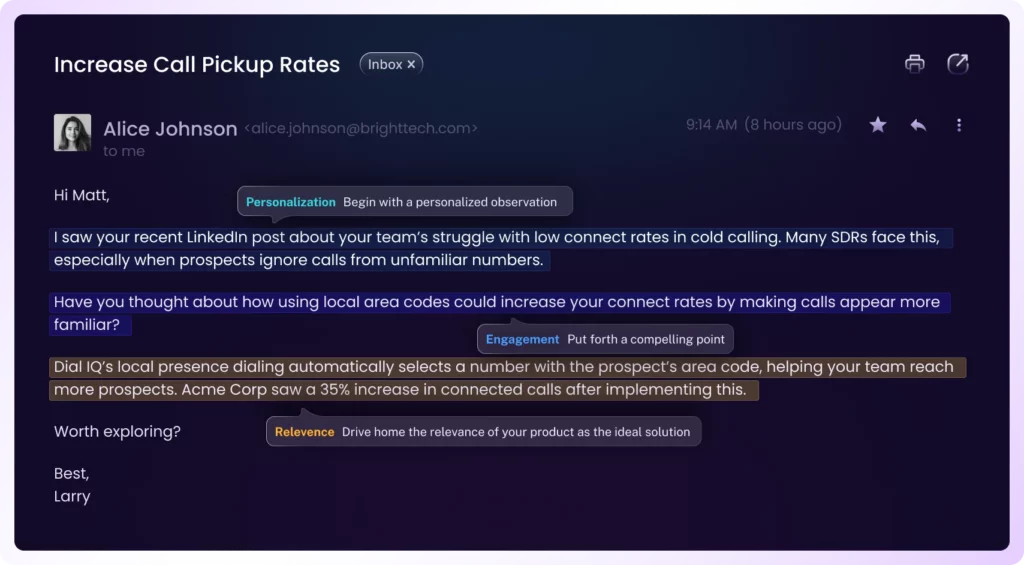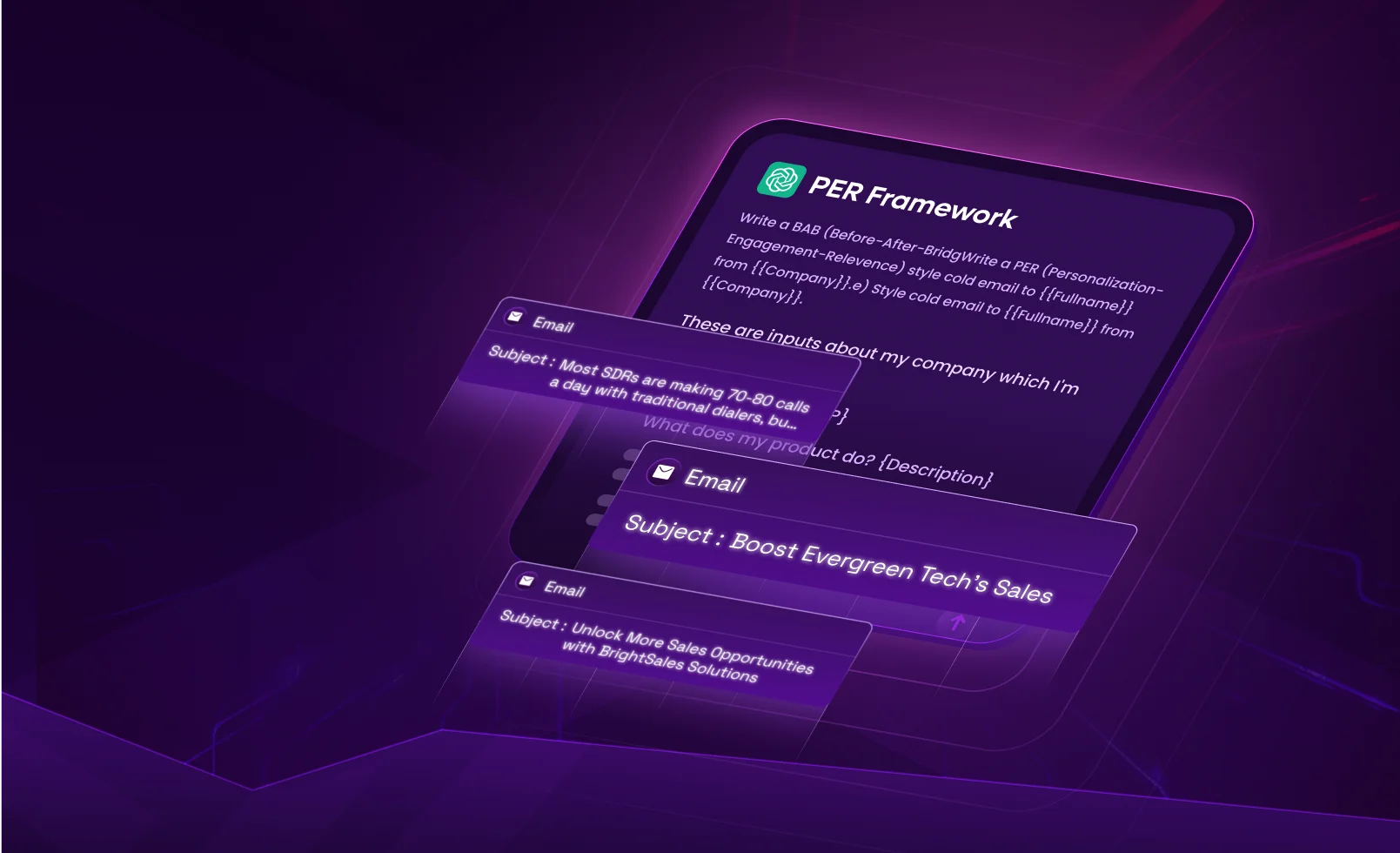Here's the truth about cold emails: If all they do is shout, "Our company is amazing! Our product is revolutionary! We're disrupting the industry!"—guess what? They're probably just sitting in your prospect's inbox, gathering digital cobwebs.
So, how do you craft a cold email that's not a self-obsessed monologue but a story about your prospect? One that grabs attention, hits a nerve, and actually gets a response?
Use copywriting frameworks. They have been used for decades to turn bland messages into powerful narratives.
The PER—Personalization-Engagement-Relevance is one of the most effective frameworks. Think of PER as a three-act play where your prospect is the star, your engagement hooks their interest, and your relevant solution provides the perfect resolution to their story.
But here's the catch: Not everyone's a natural storyteller.
Most sales reps aren't sitting around with Don Draper's knack for words. Writing a killer email takes time, skill, and the ability to use the right words and just the right tone.
This is where AI steps in.
Tools like ChatGPT can help sales reps take the heavy lifting out of email writing.
In this blog, we'll explore the PER framework, provide a ready-to-use ChatGPT prompt for creating cold emails, and share an example email generated using the framework.
What Makes PER Work?
The brilliance of PER lies in its focus on the prospect's world. Rather than leading with features or credentials, it begins with what matters most to your prospect—their specific situation and challenges.
PER hinges on showing prospects you've done your homework, creating genuine interest through engagement, and demonstrating clear relevance to their business needs. By centering the prospect throughout the message, PER creates emails that feel like the beginning of a conversation rather than a cold pitch.
1. Personalization: The Art of Research
The first component focuses on demonstrating that you've done your homework. This isn't about vague statements or generic flattery - it's about referencing something specific and meaningful to the prospect. The key is showing that this email was crafted specifically for them, not blasted to thousands.
2. Engagement: Create Genuine Interest
The engagement phase draws the prospect in by asking a thought-provoking question or making a statement that prompts reflection. This creates an interactive element that transforms the email from a one-way broadcast to the beginning of a dialogue. The goal is to make them think, "That's actually a good question."
3. Relevance: Connect with Context
Having established personalization and engagement, the relevance section shows exactly why your solution matters to their specific situation. This isn't about listing features - it's about connecting the dots between their world and your offering. The key is making your solution feel like a natural extension of the conversation rather than an abrupt pitch.
💡 ChatGPT Prompt: PER FRAMEWORK
Write a PER (Personalization-Engagement-Relevance) style cold email to {{Fullname}} from {{Company}}. These are inputs about my company which I'm trying to sell:
Ideal Customer: {ICP}
What does my product do? {Description}
The value we provide for the user: {Value Proposition}
What pain points do we solve? {Painpoints}
Competitor Advantage: {Competitor Advantage}
How we have helped people: {Case Study}
This is the input about the prospect: {Prospect_Research}
Write the subject in the following format:
Keep it simple, stating the main topic of the email. Avoid being overly creative or fancy. Limit it to 3-4 words max.
Write the email in the following format:
Personalization: Begin by referencing something specific about the prospect, {{Company}}, based on {Prospect_Research}. This could be a recent achievement, initiative, or quality that stands out. Show that we've taken the time to understand their business and context.
Engagement: Pose an engaging question or make a statement that prompts the prospect to think about a challenge or opportunity they might be facing. This could be tied to industry trends or their specific goals, encouraging them to consider how they could improve or grow.
Relevance: Introduce our product, {Description}, as a tailored solution to the problem or opportunity identified. Emphasize the value it can bring to them, providing a relevant example from {Case Study} to illustrate how it's worked for similar companies.
End with a CTA - Either "Worth a chat?" or "Worth exploring?".
Guidelines:
Keep the email under 80 words.
Use a friendly, direct tone.
Make sure to bring forth all the mentioned elements of formatting.
Avoid vague terms like "streamline," "optimize," "maximize," etc.
Be as specific as possible without making assumptions about the prospect.Sample Output:

Conclusion
The PER framework and prompt provided are your blueprints for writing personalized cold emails that create genuine connections.
But the real challenge is scaling this personalized approach for hundreds of prospects. Even with AI, executing this effectively at scale is a struggle.
That's why we built SDRx—an AI outbound agent that handles everything from in-depth prospect research to perfectly timed follow-ups, creating qualified pipeline without the manual grind.
By analyzing prospect behavior and leveraging 25 copywriting frameworks, SDRx generates highly personalized emails at scale, ensuring every outreach is relevant and impactful.
Want to use AI to create personalized, human-like emails for every prospect?
Book a demo of SDRx today.


